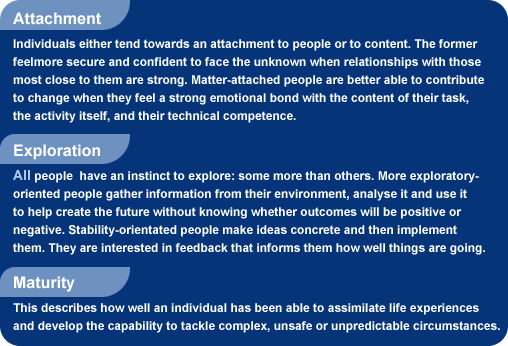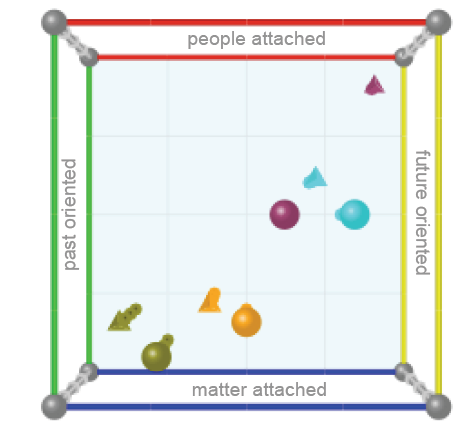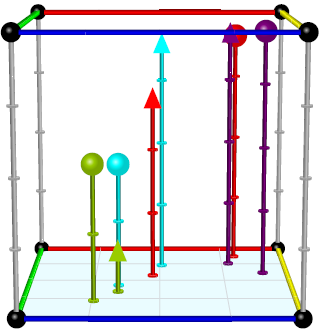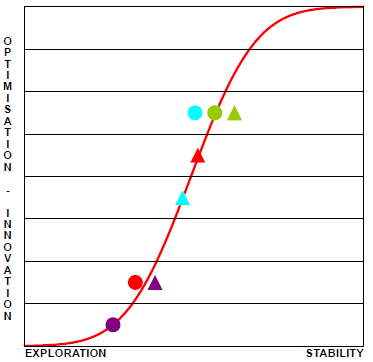The acronym “AEM” is derived from the methodology's three core dimensions - Attachment, Exploration and Managing contribution (formerly called Approach to Complexity). The ‘Cube’ in the name refers to the fact that these three dimensions can be portrayed in a three dimensional space.
Based on 30 years of research by a Dutch Professor Peter Robertson (founder of Human Insight) the three dimensions that comprise an AEM-cube® originate in the science of biology (evolution theory: ethology, attachment theory), from the work of Nobel Prize winners Lorenz and Tinbergen, and cybernetics and systems theory.
This foundation results in the AEM-cube® being an ecological model with a focus on performance outcomes: a hallmark that speaks to Profit & Loss responsible managers and leaders, strategists and investors as well as Human Resource and Organisation Development professionals wanting to connect talent with business, and an outstandingly appreciative and sustainable approach to the development and growth of talent and personal contribution
It is 21st century new approach to leadership and how to support leadership teams to execute strategy and deal with uncertainty, complexity and economic crises. The AEM-cube® can be used for everything to do with performance and wherever the need to appreciate talent exists –at the individual, team and organisational levels. AEM-cube® is culturally independent and is used in Asia, America, Africa and Europe by multi-national companies, government agencies, not for profit organization, institutions and SME.
This tool helps to describe and assess the characteristics of an individual’s which relate directly to their contribution in each of the phrases of a business cycle and wanting to make a connection between their talent and the business.
AEM Cube® assist to align the strengths between teams and individuals to corporate strategic goals. This method which captures and organized data in such a way that the connection between a strategic task and an individual and the team to which they belong is immediately visible.
The AEM-cube® base on a 360° feedback metaphor, the resulting report shows an individual's and teams' posture towards change, challenges, task and purpose. This enables individuals to understand their performance within a team verse their task. The report links the need for diversity of thinking with the need for congruence of vision, value and behaviour as a platform to building powerful teams, and increasing trust and performance in order to gain profitable and more importantly to maintain sustainability.
The AEM-cube® gathers data on 3 scales: attachment, maturity and exploration:

Growth Curve and AEM-Cube®
- Growth Curves
The unfolding of growth over time is a universal process. A slow start, usually requiring considerable investment in resources, is followed by an acceleration leading to performance, results and profits. In turn, this is followed by a deceleration in which return on effort diminishes and eventually ceases. The use of Growth-curve Organisation integrates the measurement of two key dimensions - growth and time.
Growth: this dimension informs the current stage of the growth process
Time: as with all things in nature, time travels in one direction, from beginning to end In combination, these dimensions inform the state of advancement in the growth process of a given organisation / unit; which stage in the growth lifecycle the organisation / unit is currently in, the implications of the next stage and what will be required
- How AEM Cube Three key performance dimensions assist companies in performance management measurement
Attachment:
this dimension informs the aspect of growth to which an individual’s performance optimally contributes; a markets / relationships aspect (“whom I do things with") or products / technical aspects ("what I do"); performance in the process of bringing products / services to market.
Exploration:
this dimensions informs the stage of growth an individual’s performance optimally contributes to; everybody can be creative, but people vary as to the levels of exploratory or optimising behaviour they exhibit; whether they best contribute to the earlier, or later, stages of the growth process.
Managing contribution:
formerly called Approach to Complexity, this dimension informs the perspective with which individual’s make their contribution; centred on the stage of growth they optimally contribute to, differentiating the growth process; or centred on the wider needs of all growth stages, via a system perspective; integrative.



The AEM-Cube® measures where one has an optimal contribution to the growth curve and also what kind of growth curves one prefers.
Contact us for more information about how the AEM-Cube® can enhance your professional growth.